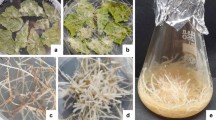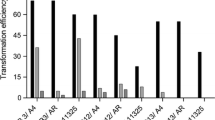Abstract
Transgenic plants of rose-scented geranium (Pelargonium graveolens cv. Hemanti) have been produced from Agrobacterium rhizogenes (strains A4 and LBA9402) mediated hairy root cultures. Amongst the explants tested, leaves were most responsive followed by the petioles and internodal segments, respectively. The A4 strain performed better for all the three explants both in terms of frequency of response and time requirement for hairy root induction. Transgenic shoots could be obtained by spontaneous regeneration without intervening callus phase amongst 16% and 12% root lines of A4 and LBA 9402 origin, respectively, or they were induced in 29% and 22% hairy root lines of A4 and LBA9402 origin, respectively, with different hormonal supplementation. These transgenic plants showed 30% survival as against 90% of their control under the confined environment of glasshouse. The transgenic plants were of similar morphotype having increased branching, higher number of leaves with increased dentations, short and round stature, highly branched root system and absence of leaf wrinkling. These transgenic plants showed opine positive results even after 5 months of their transfer to the glasshouse. The essential oil compositions of 81% of these transgenics were qualitatively similar to that of the wild type parent. However, two transgenic plants (LZ-3 and 14TG) showed increase in concentrations of geraniol and geranyl esters signifying improved oil quality with respect to the citronellol:geraniol ratio. These two oils having better olfactory value represent an improvement over that of the wild type parent from the commercial point of view.



Similar content being viewed by others
Abbreviations
- MS:
-
Murashige and Skoog’s medium
- IBA:
-
Indole butyric acid
- BAP:
-
6-Benzylaminopurine
- NAA:
-
Naphthaleneacetic acid
- GC:
-
Gas chromatography
- GC/MS:
-
Gas chromatography mass spectroscopy
References
Adams RP (1995) Identification of essential oils by gas chromatography mass spectroscopy. Allured Publication Corporation, Carol Stream II, USA
Banerjee S, Naqvi AA, Mandal S, Ahuja PS (1994) Transformation of Withania somnifera (L) Dunal by Agrobacterium rhizogenes: infectivity and phytochemical studies. Phytother Res 8:452–455
Banerjee S, Rahman L, Uniyal GC, Ahuja PS (1998) Enhanced production of valepotriates by Agrobacterium rhizogenes induced hairy root cultures of Valeriana wallichii DC. Plant Sci 131:203–208
Banerjee S, Zehra M, Gupta MM, Kumar S (1997) Agrobacterium rhizogenes mediated transformation of Artemisia annua: prodcution of transgenic plants. Planta Med 63:467–469
Boase MR, Bradley JM, Borst NK (1998) An improved method for transformation of regal Pelargonium (Pelargoniuin × domesticum Dubonnet) by Agrobacteriurn tumefaciens. Plant Sci 139:59–69
Boase MR, Deroles SC, Winefield CS, Butcher SM, Borst NK, Butler RC (1996) Genetic transformation of Regal Pelargonium (Pelargonium × domesticum Dubormet) by Agrobacterium tumefaciens. Plant Sci 121:47–61
Finnegan J, Elroy DMC (1994) Transgene inactivation: plants fight back. Biotechnol 12:883–888
Giri A, Banerjee S, Ahuja PS, Giri CC (1997) Production of hariy roots in Aconitum heterophyllum wall using Agrobacterium rhizogenes. In vitro Cell Dev Biol (Plant) 33:280–284
Hassanein A, Chevreau E, Dorion N (2005) Highly efficient transformation of zonal (Pelargonium × hortorum) and scented (P. capitatum) geraniums via Agrobacterium tumefaciens using leaf discs. Plant Sci 169: 532–541
Hooykass PJJ, Klapwijk PM, Nuti PM, Shilperoot RA, Rorsch A (1977) Transfer of the Agrobacterium turnefaciens Ti plasmid to avirulent Agrobacteria and rhizobium explanta. J Genet Microbiol 98:477–484
Jenmings W, Shibamoto J (1980) Qualitative analysis of flavor and fragrance volatiles by glass capillary gas chromatography. Academic Press, New York IX
Jung G, Tepfer D (1987) Use of genetic transformation by the Ri T-DNA of Agrobacteriuin rhizogenes to stimulate biomass and tropane alkaloid production in Atropa belladonna and Calystegia cepium roots grown in vitro. Plant Sci 50:145–151
Khanuja SPS, Kalra A, Singh AK (2005) Gains from Entrepreneurship. In: Ram N (ed) The Hindu–Survey of Indian Agriculture, National Press, Chennai, India pp 191–194
Khanuja SPS, Shasany AK, Dhawan S, Kumar S (1998) A rapid procedure for isolating somaclones of altered genotypes in Mentha arvensis. J Med Arom Plant Sci 20:359–361
KrishnaRaj S, Bi YM, Saxena PK (1997) Somatic embryogenesis and Agrobacterium mediated transformation system for scented geranium (Pelargonium sp. ‘Frensham’). Planta 201:434–440
Kubba AS, Tilney-Basset RAE (1981) Genetical studies of embryo survival and embryo breakdown in Pelargonium × hortorum Bailey. Euphytica 30:881–887
Kumpatla SP, Chandrasekharan MB, Iyer LM, Guofu L, Hall TC (1998) Genome intruder scanning and modulation systems and transgene silencing, Trends Plant Sci 3:97–104
Lawrence BM (1984) Progress in Essential oils. Perfumer Flay 9:87–95
Morgan AJ, Cox PN, Turner DA, Peel E, Davey MR, Gartland KMA, Mulligan BJ (1987) Transformation of tomato using an Ri plasmid vector. Plant Sci 49:37–49
Narayana MR, Prakasa Rao EVS, Rao BRR, Sastry KP (1986) Geranium cultivation in India: Potentials and Prospects. Pafai J 8:25–30
Ooms G, Karp A, Burrell MM, Twell D, Roberts J (1985) Genetic modification of potato development using Ri T-DNA. Theor Appl Genet 70:440–446
Ottaviani MP, Schel JHN, Hanisch Ten Cate ChH (1990) Variation in structure and plant regeneration of Agrobacterium rhizogenes transformed and control roots of the potato cv. Bintje. Plant Cell Tiss Org Cult 20:25–34
Pellegrineschi A, Dawson JP, Valtorta N, Paillard N, Tepfer D (1994) Improvement of ornamental characters and fragrance production in Lemon-scented geranium through genetic transformation by Agrobacterium rhizogenes. Biotechnology 10:64–68
Pellegrineschi A, Mariani OD (1996) Agrobacterium rhizogenes mediated transformation of scented geranium. Plant Cell Tiss Org Cult 47:79–86
Perez-Morphe-Balch E, Ochoa-Alejo E (1987) Regeneration of transgenic plants of Mexican line from Agrobacterium rhizogenes transformed tissues. Plant Cell Rep 17:591–596
Porter JR (1991) Host range and implications of plant infection by Agrobacterium rhizogenes. Crit Rev Plant Sci 10:387–421
Rao BRR, Bhattacharya AK, Kaul PN (1999) Rose scented geranium (Pelargonium graveolens L.) cultivation and technology for Andhra Pradesh. Indian Perf 43:2–8
Robichon MP, Renou JP, Jalouzot R (1995) Genetic transformation of Pelargonium hortorum. Plant Cell Rep 15: 63–67
Rodrigues MMA, Stafford A, Cresswell R, Ariascastro C (1991) Bioreactors for growth of plant roots. Enz Microb Technol 13:697–702
Saxena G, Banerjee S, Rahman L, Mallavarapu GR, Sharma S, Sushil Kumar (2000) An efficient in vitro procedure for micropropagation and generation of somaclones of rose-scented Pelargonium. Plant Sci 155:133–140
Shoyama Y, Zhu X, Nakai R, Shiraishi S, Kohda H (1997) Micropropagation of Panax notoginseng by somatic embryogenesis and RAPD analysis of regenerated plantlets. Plant Cell Rep 16:450–453
Teisseire P (1987) Industrial quality control of essential oils by capillary GC. In: Sandri P, Beichi C (ed) Capillary gas chromatography in essential oil analysis. Huethig, Heidelberg, pp 215–258
Tempe J, Casse-Deebart F (1989) Plant gene vectors and genetic transformation: Agrobacterium Ri plasmids. In: Cell culture and somatic cell genetics of plants. Molecular Biology of Plant Nuclear genes, vol. 6. Academic Press, pp 26–49
Tepfer D (1984) Transformation of several species of higher plants by Agrobacterium rhizogenes: sexual transmission of the transformed genotype and phenotype. Cell 37:659–967
Yamazaki M, Kobayashi M, Saito K (1997) Transformation of Perilla frutescens var, crispa using Agrobacterium –Ri binary vector system. Plant Biotechnol 14:169–173
Zehra M, Banerjee S, Naqvi AA, Kumar S (1998) Variation in the growth and a production capability of the hairy roots of Hyoscyamus albus, H. muticus and their somatic hybrid. Plant Sci 136:93–99
Zehra M, Banerjee S, Sharma S, Kumar S (1999) Influence of Agrobacterluin rhizogenes strains on biomass and alkaloid productivity in hairy root of Hyoscyamus muticus and H. albus. Planta Med 65:60–63
Acknowledgements
The authors are thankful to the Department of Biotechnology, Government of India for the financial support and the Regional Sophistication Instrumentation Facility, CDRI, Lucknow for GC-MS of the oils. Thanks are also due to S. Sharma and S.A. Hasan for their help in manuscript preparation and A.P. Dhiman for photography.
Author information
Authors and Affiliations
Corresponding author
Rights and permissions
About this article
Cite this article
Saxena, G., Banerjee, S., Laiq-ur-Rahman et al. Rose-scented geranium (Pelargonium sp.) generated by Agrobacterium rhizogenes mediated Ri-insertion for improved essential oil quality. Plant Cell Tiss Organ Cult 90, 215–223 (2007). https://doi.org/10.1007/s11240-007-9261-0
Received:
Accepted:
Published:
Issue Date:
DOI: https://doi.org/10.1007/s11240-007-9261-0




